| Listing 1 - 10 of 523 | << page >> |
Sort by
|
Book
ISBN: 2902709099 9782902709090 Year: 1979 Publisher: Grenoble Publ. de l'Université des langues et lettres
Abstract | Keywords | Export | Availability | Bookmark
 Loading...
Loading...Choose an application
- Reference Manager
- EndNote
- RefWorks (Direct export to RefWorks)
Grammar --- Grammar, Comparative and general --- Comparative grammar --- Grammar, Philosophical --- Grammar, Universal --- Language and languages --- Philosophical grammar --- Linguistics --- Philology --- Grammar, Comparative --- Grammar, Comparative and general.
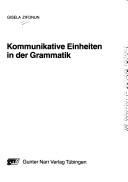
ISBN: 3878086679 9783878086673 Year: 1987 Volume: 65 Publisher: Tübingen Narr
Abstract | Keywords | Export | Availability | Bookmark
 Loading...
Loading...Choose an application
- Reference Manager
- EndNote
- RefWorks (Direct export to RefWorks)
Grammar --- German language --- Grammar, Comparative and general --- Comparative grammar --- Grammar, Philosophical --- Grammar, Universal --- Language and languages --- Philosophical grammar --- Linguistics --- Philology --- Grammar, Comparative
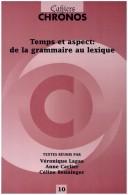
ISBN: 9042011335 9401209278 9789042011335 9789401209274 Year: 2002 Volume: 10 Publisher: Amsterdam ; New York : Rodopi,
Abstract | Keywords | Export | Availability | Bookmark
 Loading...
Loading...Choose an application
- Reference Manager
- EndNote
- RefWorks (Direct export to RefWorks)
Temporalité et aspect peuvent être exprimés tant par la grammaire que par le lexique. De la comparaison entre langues, il ressort toutefois qu'il n'est pas possible d'établir une répartition, valable pour toutes les langues, des tâches dévolues respectivement à la grammaire et au lexique dans l'expression du temps et de l'aspect. Pour l'aspect en particulier, les différences entre les langues sont grandes. Ainsi certaines oppositions qui relèvent de l'aspect lexical en français se présentent comme grammaticalisées dans les langues slaves. Même à l'intérieur d'une même langue, on ne peut admettre l'existence d'une réelle frontière entre grammaire et lexique. En effet, certains marqueurs temporels ou aspectuels se trouvent dans la zone frontière entre ces deux domaines. Il en va ainsi des semi-auxiliaires d'aspect en français : leur origine étant lexicale, ils ont subi un processus de grammaticalisation qui n'a toutefois pas entièrement abouti. Par ailleurs, on observe des interférences voire des incompatibilités entre aspect grammatical et aspect lexical. Le présent recueil, qui réunit des contributions à la troisième édition du colloque Chronos (Valenciennes, 29-30 octobre 1998), se propose d'ouvrir des pistes de réflexion en explorant quelques-uns des moyens propres à l'expression de la localisation temporelle et de l'aspect, des plus grammaticalisés aux plus nettement lexicaux, en particulier la construction verbale (A. Carlier, V. Lagae), l'auxiliaire be associé à V- ing (G. Girard, G. Mélis), les semi-auxiliaires (D. Battistelli et J.-P. Desclés), les préfixes (D. Amiot, A. Israeli, D. Paillard), les compléments temporels (L. José, H. de Penanros) et les noms (N. Flaux, K. Paykin).
Lexicology. Semantics --- Grammar --- Grammar, Comparative and general --- Lexicology --- Aspect --- Temporal constructions --- Comparative grammar --- Grammar, Philosophical --- Grammar, Universal --- Language and languages --- Philosophical grammar --- Linguistics --- Philology --- Grammar, Comparative
Book
ISBN: 3494020094 9783494020099 Year: 1971 Volume: 94 Publisher: Heidelberg Quelle und Meyer
Abstract | Keywords | Export | Availability | Bookmark
 Loading...
Loading...Choose an application
- Reference Manager
- EndNote
- RefWorks (Direct export to RefWorks)
Grammar --- Grammar, Comparative and general --- Grammar, Comparative and general. --- Comparative grammar --- Grammar, Philosophical --- Grammar, Universal --- Language and languages --- Philosophical grammar --- Linguistics --- Philology --- Grammar, Comparative
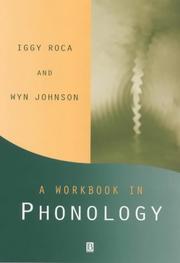
ISBN: 0631213945 9780631213949 Year: 2002 Publisher: Oxford Blackwell
Abstract | Keywords | Export | Availability | Bookmark
 Loading...
Loading...Choose an application
- Reference Manager
- EndNote
- RefWorks (Direct export to RefWorks)
Grammar, Comparative and general --- -Comparative grammar --- Grammar --- Grammar, Philosophical --- Grammar, Universal --- Language and languages --- Philosophical grammar --- Linguistics --- Philology --- Phonology --- Grammar, Comparative --- Comparative grammar --- Grammar, Comparative and general - Phonology
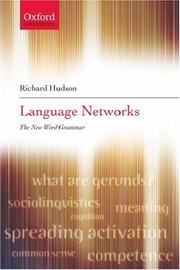
ISBN: 1280756713 0191514845 1429460237 9780191514845 9781429460231 9786610756711 6610756716 0199267308 0199298386 9780199298389 9780199267309 9781280756719 1383040974 Year: 2007 Publisher: Oxford ; New York : Oxford University Press,
Abstract | Keywords | Export | Availability | Bookmark
 Loading...
Loading...Choose an application
- Reference Manager
- EndNote
- RefWorks (Direct export to RefWorks)
Richard Hudson presents a theory of how we learn and use our knowledge of language, and puts this to work in a series of extended explorations of morphology, syntax, semantics, and sociolinguistics.
Grammar, Comparative and general. --- Comparative grammar --- Grammar --- Grammar, Philosophical --- Grammar, Universal --- Language and languages --- Philosophical grammar --- Linguistics --- Philology --- Grammar, Comparative --- Grammar, Comparative and general --- Vergelijkende en algemene grammatica.
Book
ISBN: 1108937977 1108935117 1108832105 1108934358 1108932827 9781108832106 9781108932820 Year: 2021 Publisher: Cambridge, UK ; New York : Cambridge University Press,
Abstract | Keywords | Export | Availability | Bookmark
 Loading...
Loading...Choose an application
- Reference Manager
- EndNote
- RefWorks (Direct export to RefWorks)
A classical viewpoint claims that reality consists of both things and stuff, and that we need a way to discuss these aspects of reality. This is achieved by using +count terms to talk about things while using +mass terms to talk about stuff. Bringing together contributions from internationally-renowned experts across interrelated disciplines, this book explores the relationship between mass and count nouns in a number of syntactic environments, and across a range of languages. It both explains how languages differ in their methods for describing these two fundamental categories of reality, and shows the many ways that modern linguistics looks to describe them. It also explores how the notions of count and mass apply to 'abstract nouns', adding a new dimension to the countability discussion. With its pioneering approach to the fundamental questions surrounding mass-count distinction, this book will be essential reading for researchers in formal semantics and linguistic typology.
Grammar, Comparative and general --- Semantics --- Language and languages --- Mass nouns --- Numerals --- Quantifiers --- Philosophy --- Comparative grammar --- Grammar --- Grammar, Philosophical --- Grammar, Universal --- Philosophical grammar --- Linguistics --- Philology --- Grammar, Comparative
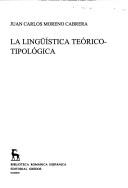
ISBN: 8424916794 9788424916794 Year: 1995 Volume: 389 Publisher: Madrid Gredos
Abstract | Keywords | Export | Availability | Bookmark
 Loading...
Loading...Choose an application
- Reference Manager
- EndNote
- RefWorks (Direct export to RefWorks)
Linguistics --- Typology (Linguistics) --- Grammar, Comparative and general. --- Grammar, Comparative and general --- Language and languages --- Linguistic typology --- Linguistic universals --- Comparative grammar --- Grammar --- Grammar, Philosophical --- Grammar, Universal --- Philosophical grammar --- Philology --- Typology --- Classification --- Grammar, Comparative --- Typology (Linguistics).
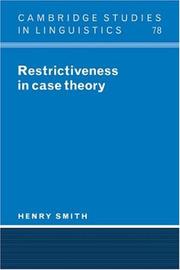
ISBN: 0521462878 0521026555 0511519974 9780521462877 9780511519970 9780521026550 Year: 1996 Volume: 78 Publisher: Cambridge Cambridge University Press
Abstract | Keywords | Export | Availability | Bookmark
 Loading...
Loading...Choose an application
- Reference Manager
- EndNote
- RefWorks (Direct export to RefWorks)
Henry Smith develops a theory of syntactic case and examines its synchronic and diachronic consequences. Within a unification-based framework, the book draws out pervasive patterns in the relationship between morphosyntax ('linking') and grammatical function. The theory proposed consists of three ordered constraints on the association of NPs and arguments, based on the central notion of 'restrictiveness'. Beginning with a detailed study of dative substitution in Icelandic, the author moves on to examine a wide array of synchronic and diachronic data and to construct a typology of case. Theoretically innovative and sophisticated, and descriptively wide-ranging, this book will appeal to all those interested in the cross-linguistic marking of case and the ways in which case systems may change over time.
Grammar --- Grammar, Comparative and general --- Grammaire --- --Théories --- Cas --- --Case --- 1552 --- -Comparative grammar --- Grammar, Philosophical --- Grammar, Universal --- Language and languages --- Philosophical grammar --- Linguistics --- Philology --- Case --- Grammar, Comparative --- Case. --- -Case --- Arts and Humanities --- Language & Linguistics --- Grammar, Comparative and general - Case
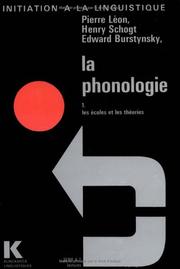
ISBN: 2252017953 9782252017951 Year: 1977 Volume: 7 Publisher: Paris : Klincksieck,
Abstract | Keywords | Export | Availability | Bookmark
 Loading...
Loading...Choose an application
- Reference Manager
- EndNote
- RefWorks (Direct export to RefWorks)
Phonetics --- Grammar, Comparative and general --- Phonology --- History --- -Comparative grammar --- Grammar --- Grammar, Philosophical --- Grammar, Universal --- Language and languages --- Philosophical grammar --- Linguistics --- Philology --- -History --- Grammar, Comparative --- History. --- -Phonology --- -Linguistics --- Grammar, Comparative and general - Phonology - History --- LINGUISTIQUE --- PHONOLOGIE
| Listing 1 - 10 of 523 | << page >> |
Sort by
|

 Search
Search Feedback
Feedback About UniCat
About UniCat  Help
Help News
News